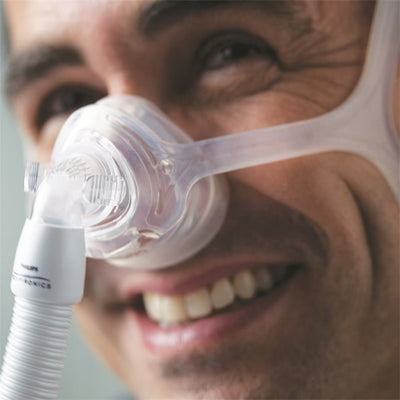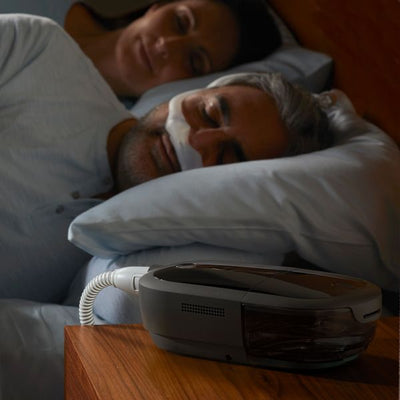Did you know there are actually two kinds of sleep apnea? While both obstructive sleep apnea and central sleep apnea cause breathing disruptions during sleep, how these disruptions occur can vary.
With both obstructive and central sleep apnea, a temporary pause in breathing will cause the sleeper to temporarily wake up to restart the breathing process. Individuals can experience dozens of these sleep interruptions per hour, keeping them from getting rejuvenating deep sleep and leaving them exhausted the next day.
While the end result is similar, understanding whether you are dealing with obstructive or central sleep apnea is key to figuring out the right treatment plan for your needs. Here’s what you should know about these conditions.
What You Need to Know About Obstructive Sleep Apnea

When most people think of sleep apnea, they’re probably thinking of obstructive sleep apnea. In fact, obstructive sleep apnea is believed to affect as many as 30 percent of adults in the United States, and makes up the vast majority of sleep apnea cases in general.
Obstructive sleep apnea is when the throat becomes blocked or constricted during sleep, restricting the flow of air. This can occur when the fatty tissues in the throat collapse as the muscles relax, or if the tongue falls back into a position that blocks airflow. This not only restricts breathing, but it can also contribute to snoring.
One of the biggest risk factors for obstructive sleep apnea is being overweight. Being overweigh or obese results in more fatty tissue around the neck, which increases the likelihood of the throat getting blocked during sleep. Other physical features, such as a wide neck, large tongue, or shorter jaw can also increase the likelihood of obstructive sleep apnea.
You can control some other risk factors for obstructive sleep apnea, such as sleeping on your back, using alcohol before bed, or smoking. However, risk will generally increase for all people as they get older, particularly if they have a family history of obstructive sleep apnea or certain hormone conditions.
Obstructive sleep apnea is treated using CPAP machines, which provide a flow of pressurized air throughout the night. The pressurized air keeps the throat from collapsing during sleep to prevent nighttime disruptions. The pressure level is determined based on the severity of your sleep apnea.
Individuals with obstructive sleep apnea may also be advised to improve diet and exercise to lose weight so they can reduce the severity of their condition.
Central Sleep Apnea — What it is and How to Treat it
Central sleep apnea is far less common than obstructive sleep apnea. In fact, it’s estimated that only one percent of adults deal with central sleep apnea.
Central sleep apnea occurs when the brain experiences communication disruptions with the muscles that control breathing. For example, the brain stem might not recognize carbon dioxide levels in the body, and as a result, fail to send appropriate signals to the breathing muscles. This can cause shallow breathing and complete pauses in breathing.
Unlike obstructive sleep apnea, the causes behind central sleep apnea aren’t as clearly defined. It is believed to often be a byproduct of other health conditions, including brain steam injuries, kidney failure, stroke, and heart failure. The risk for central sleep apnea also increases with age, and when taking certain prescription medications. Sleeping at high altitude can also trigger central sleep apnea.
Because of its link with other medical conditions, “treatment” for sleep apnea often involves getting treatment for any other medical issues the person might be dealing with. And of course, the use of a CPAP machine is often recommended to prevent breathing disruptions at night.
How Can You Tell If You Have Sleep Apnea?

While the reasons why central sleep apnea and obstructive sleep apnea occur may vary, they share many of the same symptoms. The end result is the same: disrupted sleep that makes it hard to feel fully rested din the morning.
As a result, people with sleep apnea usually experience extreme fatigue during the day. In some cases, this fatigue can be so severe that they might fall asleep during other activities, including work or driving. Trouble concentrating and increased irritability are also common. People with sleep apnea are also more likely to have restless sleep with frequent awakenings and morning headaches.
Because obstructive sleep apnea results from constricted airways, they might also have a dry mouth or throat irritation in the morning. People with obstructive sleep apnea often snore or make gasping or choking sounds during sleep. On the other hand, those with central sleep apnea likely won’t snore, but will instead have shortness of breath and nighttime chest pains.
If you are experiencing these symptoms, you should talk to a doctor to go over your health history. Based on their findings, they may recommend a sleep study, where specialists will track your breathing, heart rate, and other vitals during sleep to diagnose sleep apnea and determine which treatment will work best for you.
Get Your CPAP Equipment From Help Medical Supplies
While CPAP and BiPAP machines can help individuals with either obstructive sleep apnea or central sleep apnea, there’s no denying that this equipment can be very expensive if you don’t have insurance to help foot the bill.
With Help Medical Supplies, you don’t have to worry about this necessary medical equipment breaking the bank. We offer discounted prices on CPAP machines, masks, and other accessories, as well as free shipping on most orders of $99 or more. Select purchases also qualify for interest-free financing to help make your purchase more manageable.
With the right CPAP equipment, you can get the quality sleep you need, regardless of the type of sleep apnea you’re dealing with.

